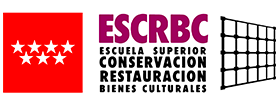Entrance Exam: Structure
The specific entrance examination to the Degree in Higher Artistic Studies in Conservation and Restoration of Cultural Heritage at the ESCRBC will be common to all specialisations and will consist of two exercises:
• The first exercise, written and of a theoretical nature, will have a maximum duration of two hours. It will cover the contents of one of the following subjects of the Spanish Baccalaureate: Art History, Physics, Chemistry, or Biology.
The candidates shall choose and answer one among ten proposed topics: four in Art History, two in Physics, two in Chemistry, and two in Biology. Together with the discussion of the chosen topic, an outline of the content and a final summary highlighting the main conclusions or concepts will be included. In addition to specific knowledge, this exercise will assess the relationship of this knowledge with general or multidisciplinary knowledge, the appropriate use of language, the ability to summarise, and general training in the field of cultural heritage.
This first exercise will be marked out of ten. The marks shall be expressed to two decimal places, rounded to the nearest hundredth, rounding up if equidistant. The first exercise will be considered passed when the mark obtained is equal to or higher than five points.
• The second exercise, of a practical nature, will last for a maximum duration of six hours and will consist of the following parts:
1. Practical aptitude. This will consist of a practical exercise in which the specific skills required for the studies of Conservation and Restoration of Cultural Heritage will be assessed. Skill, precision, and care in carrying out the work will be assessed. The maximum duration of the practical skill exercise shall be two hours.
2. Colour. This shall consist of an exercise on the representation of colour. The proper application of the techniques used and the degree of understanding of the values and qualities of colour shall be evaluated. The maximum duration of the colour exercise will be two hours.
3. Drawing. This will consist of a drawing from life with a mimetic approach based on a free-standing, inanimate model. Faithfulness in the representation, the quality of the artwork, the precision, and finishing of the work will be assessed. The maximum time allowed for the drawing exercise is four hours.
Each part of the second exercise will be marked out of ten. The mark for the second exercise will be the average of the marks obtained in its parts and will be expressed to two decimal places, rounded to the nearest hundredth, and rounded up if equidistant. The second exercise shall be considered to have been passed when the mark obtained is equal to or higher than five points.
In order to pass the specific entrance examination, it will be necessary to pass the two exercises. The final mark for the specific entrance examination will be the weighted average of the marks obtained in both exercises, with the first exercise being worth 40% and the second one 60%. This final mark shall be expressed in numerical terms, using a scale from zero to ten, to two decimal places, rounded to the nearest hundredth and, if equidistant, rounded up. A final mark of five or higher is required to pass the entrance examination.
The entrance examinations held in recent years can be found here .



